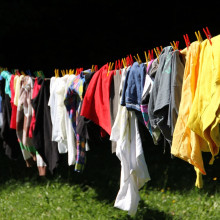Kevin got in touch ask why clothes dried on a washing line can end up feeling rough, crunchy and stiff... To find out, our Laura Brooks contacted Neil Lant at the Fabric and Home Care research and development division of Proctor and Gamble, who make Lenor fabric softener.
In this episode

00:00 - Why does line drying make clothes rough?
Why does line drying make clothes rough?
Laura Brooks put this to Neil Lant, research Fellow in the Fabric & Home Care division of Proctor and Gamble, who make Lenor fabric softener. Laura - Everyone loves the feel of a soft warm towel straight from the tumble dryer but towels dried on a washing line can end up crunchy and stiff. Why does this happen?
Holly on FaceBook thinks too much soap could be to blame.
Meanwhile on our forum, Atomic S suggested that the movement from a tumble dryer would loosen up fibres making them softer.
To find out more I contacted Neil Lant, Research Fellow in the Fabric and Homecare division of Procter and Gamble who make Lenor fabric softener.
Neil - Our fingertips alone have over two and a half thousand sensory receptors and our brains are constantly interpreting how things feel, sometimes at a subconscious level. When we pull clothes off the line or out of the dryer our brains are focused on the task at hand and we immediately know whether our laundry feels stiff and rough or whether it feels soft and flexible.
The feel and softness of a garment is impacted by the physical properties: smoothness, flexibility, and fullness. These physical properties are affected by the original garment construction, the type of any finish used, the fibre type and, of course, how it's laundered. A fabric that's made from a tight weave with highly twisted yarns like a cotton terry towel has a fullness to it because the rigid fibres can support the structure, whereas a fabric made from an knit is more elastic and has a springiness to it.
Laura - Cotton fibres are made of a natural polymer called cellulose; the same stuff we extract from wood pulp to make paper. The cellulose chains stick together by a process called hydrogen bonding which makes the cotton fibres very strong. However, cellulose is also very good at absorbing water.
Neil - In the presence of large amounts of water like in a washing machine, the fibres swell, hydrogen bonds between the polymer chains are disrupted, the chains can slip past each other, and the hydrogen bonds reform upon drying.
When fabrics are line dried, water drains and evaporates causing increased cellulose-cellulose interactions between fibres in yarns driven by capillary attraction. As the fibres de-swell new hydrogen bonds are formed within and between the fibres - it's like setting the fabric in stone. Whereas when the drying happens with motion, as in a tumble dryer, there is less opportunity for these fibre-fibre adhesions to occur.
A highly structured fabric like a terry towel has twisted yarns and loops and when new hydrogen bonds are formed the towel feels very harsh since it is rough and stiff right off the line.
- Previous Moulding the Minds of Tomorrow
- Next Nursing NASA's Astronauts










Comments
Add a comment